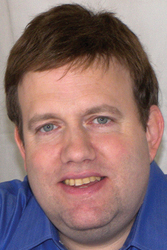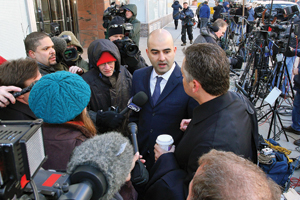No NFL game has been missed and no practices canceled, but there’s been no shortage of trash talk across the league in recent weeks.
Phrases like “liar,” “modern-day slavery” and unions across the board have “exceeded their bounds” have become commonplace. And the combination of Twitter, Facebook and other 24-hour media outlets has created what amounts to a constant screaming match, unlike any sports labor conflict in the past.
The taunting and name-calling is all part of a high-stakes battle to sway public opinion. It’s a battle that will likely have little effect on ongoing negotiations but could go a long way toward determining how deeply the fallout will be from the lockout. It’s also a dangerous game. Any lopsided shift in public opinion not only could add pressure on one side, it also could undermine the image of the league. In the long run, that could cost both owners and players revenue should the screaming match alienate fans too much.
 |
The NFL recently hired Frank Luntz, a leading Republican pollster and expert on messaging.
|
For that reason, the NFL and NFLPA have sunk tremendous time and resources into message control during the work stoppage. The NFL has recently hired Frank Luntz, a leading Republican pollster with expertise in developing phrases that resonate with the public, like Newt Gingrich’s famed “Contract With America,” and the players have hired Phil Singer, a veteran political consultant who worked on Hillary Clinton’s 2008 presidential campaign. The high-profile hirings underscore what’s at stake for each side.
“This is the preseason of communication,” said Ari Fleischer, head of Fleischer Communications and a former White House press secretary. “Come August or September, public opinion is going to become awful sharp and can create pressure on both parties. If you wait too long to be staffed up and ready, you’ve missed the boat, [because] if one side makes a mistake or one side is more savvy than another, it can shift public opinion into that lopsided area where you can get business leverage. ”
Behind the battle
The last major work stoppage in sports occurred seven years ago. When the NHL locked out players in 2004, league and union communications teams launched a nonstop battle to win public support.
NHLPA Communications Director Jonathan Weatherdon remembers long days that began with compiling news clips at 6 a.m., outlining talking points with union leadership, posting key messages for players on an internal website, working the media throughout the day, and scheduling player interviews in markets across North America.
“It was nonstop, and it never ended,” Weatherdon said.
Communications teams at the NFL and NFLPA are working similar schedules.
The NFL’s strategy is being directed by longtime NFL communications executive Greg Aiello and former Ogilvy & Mather executive Paul Hicks, who came to the league last summer.
So far, the league’s strategy has emphasized making owners more accessible to media than they have been in previous sports work stoppages. Whereas in the regular season NFL owners were fined if they spoke about labor negotiations, recently both league and team officials have been seeking the press. Media analysis after recent talks broke down shows a number of owners speaking both in the national and local marketplace about the league’s willingness to negotiate and repeating a similar refrain — that players walked away from the table and are more interested in litigation than negotiation.
Giants co-owner John Mara has been very
visible and consistent in his remarks, and only a few owners have gone off message, namely, Dolphins owner Stephen Ross, who was particularly candid in saying this was “not his idea of ownership” and highly critical of unions.
It’s unclear if ownership will continue to be vocal or yield to league officials as negotiations continue. Regardless, sports executives and media analysts all agree that the league and its owners will have to walk a fine line in talking about players because any comments that appear to vilify players would denigrate the very talent they use to market and promote their teams.
“You never want your players viewed as the bad guys or in a negative fashion,” said Dan Courtemanche, executive vice president of communications at MLS, which signed a new collective-bargaining agreement a year ago. “We knew at some point our players would be back playing for MLS clubs, and we didn’t want fans to have a negative view of players that would make them less likely to attend a game in person or view one on television.”
The NFL has several, inherent advantages in the communication battle. It does a weekly poll of 300 fans, and also has a panel of 10,000 fans it can survey occasionally — not to mention it has an e-mail database of 5 million fans it can deliver messages to directly. It’s using all three to stay in touch with fans and has tapped its e-mail database to deliver letters from Commissioner Roger Goodell about negotiations.
In addition to its own communications staff, the league also has 32 teams with their own communication departments who have relationships with news outlets in 30 markets nationwide, doubling up in New York City and the Bay Area. Those departments have established relationships with media outlets that make it easy for them to schedule interviews for owners and team executives. The value of those local ties was evident earlier this month when the NFL urged teams to have their owners and presidents speak to local media after the union decertified. One team communications director estimated 19 of 32 teams did, amplifying the league’s message that NFL players walked away from negotiations in order to drown out the players’ position that the league had locked them out.
“That’s a powerful tool leagues have,” Weatherdon said.
Let us play
George Atallah, the NFLPA’s assistant executive director of external affairs, crafted a communication strategy for players that’s designed to combat those challenges (see related story). The strategy has encouraged players to emphasize four key messages: This is a lockout, not a strike; open the NFL books; the lockout hurts local businesses; and players just want to play. The last point has been turned into the tag line, “Let Us Play,” for which the union created a commercial that CBS College Sports refused to air.
 |
KEVIN KOSKI / NFLPA
George Atallah (center) crafted a communications strategy for the players.
|
Like the NFL, which created nfllabor.com to chronicle the lockout, the players launched nfllockout.com. The site details the players’ position on what the lockout is about and provides links to stories like a recent Sports Illustrated article about NFL revenue and repeats the players’ allegation that owners won’t open the NFL’s books.
The players have supplemented the site by posting Ustream videos and direct chats with players such as Brian Dawkins, a Denver Broncos defensive back who attended the recent players meeting in Florida.
The addition of Twitter and Facebook as media platforms has made it easier for players to communicate directly with fans. Some players, like NFLPA player representative and Saints quarterback Drew Brees, have more than 400,000 followers, and have used those platforms to their advantage. The day the league locked out players, Brees wrote, “The NFL brought this fight to us — they want $1 billion back, we just want financial information to back up that request.”
But the immediacy those platforms provide mean they have some downsides, as well. Unlike the league, which has only 32 owners to keep on message and the ability to fine those who get off message, the players association has to manage and follow comments by more than 1,500 players. Atallah called the task impossible.
While players such as Alge Crumpler have stayed on message, saying “We just want to get back on the field,” others have attacked league executives personally and made incendiary remarks. As a result, the players association has had to deal with players like free agent Kevin Burnett calling Goodell a “liar” and Vikings running back Adrian Peterson comparing the NFL to slavery.
Both management and labor officials said those types of remarks and personal attacks can turn off fans whether they’re made by players or management.
“Anyone who degenerates into that type of rhetoric hurts themselves on both sides of the table,” said Stan Kasten, former president of the Washington Nationals, who worked through collective-bargaining negotiations in MLB and the NBA. “Fans don’t want to hear it. If you’re being personal and unprofessional, it maximizes the damage.”
Pulse on the polls
There’s no clear winner yet in the battle for public opinion, but early polling favors NFL players. Five of eight polls by outlets ranging from CBSsports.com to Bloomberg News show fans blame owners for the current labor unrest. The margin of blame, however, was more narrow if fans had the option of blaming both parties.
Executives who have been in labor battles downplayed the early polling results, saying that fans won’t be truly engaged in the labor issue until it affects them directly by disrupting training camp or games.
“Right now, public opinion is secondary because America has not lost this pastime,” said Ian Pulver, a hockey agent who worked as an associate counsel for the NHLPA during the 2004-05 lockout. “It’s getting ready for baseball and the NHL and NBA playoffs. America won’t speak out until they’ve lost their pastime.”
Right now, most experts agree that the NFL and NFL players’ spat appears to fans to be over nothing more than money.
“I don’t think anyone wins in a story like this,” said Kevin Sullivan, a former White House communications director. “The average person doesn’t want to hear that it’s hard to agree on how to divide up the billions, and the issues are so complex.”
The key to winning the public relations battle going forward will be changing that perception and showing how a labor agreement will benefit fans. The NHL did that by arguing that a salary cap would create more competitive balance in the league. To date, neither the NFL nor the players have effectively done that, said Mike Berland, who worked on behalf of the NHL during the 2004-05 lockout and runs market research company Penn, Schoen Berland.
“The ultimate benefit has to be the fans,” Berland said. “If you can’t articulate why there’s a dispute and how the game will end up in a better place, as a fan, you’re left wondering why they’re taking away the sport.”
The longer that remains the case, the more damaging it could be for the NFL. The league enjoys a pristine image and sustained economic success that’s unrivaled in sports, and all of that could be damaged by prolonged labor unrest.
As one senior league executive, who declined to go on the record, said, “They do everything right and everything turns to money for the good of everybody, so PR and image is extremely important to them.”
Kasten said that if a deal gets done in time for players to go to training camp, there won’t be any lasting damage from the early skirmishes in the battle for public opinion.
“Football as a product is so strong that they’ll bounce back quickly,” Kasten said, “but I’ll never take that for granted.”
One thing is clear: The NFL and its players aren’t.
Staff writers Daniel Kaplan, Liz Mullen, John Ourand and Terry Lefton contributed to this report.





